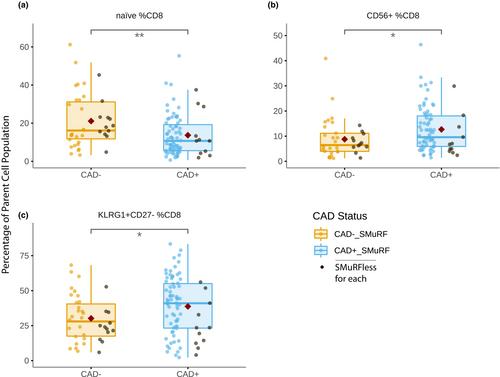Mass cytometry analysis reveals altered immune profiles in patients with coronary artery disease
Abstract
Objective
The importance of inflammation in atherosclerosis is well accepted, but the role of the adaptive immune system is not yet fully understood. To further explore this, we assessed the circulating immune cell profile of patients with coronary artery disease (CAD) to identify discriminatory features by mass cytometry.
Methods
Mass cytometry was performed on patient samples from the BioHEART-CT study, gated to detect 82 distinct cell subsets. CT coronary angiograms were analysed to categorise patients as having CAD (CAD+) or having normal coronary arteries (CAD−).
Results
The discovery cohort included 117 patients (mean age 61 ± 12 years, 49% female); 79 patients (68%) were CAD+. Mass cytometry identified changes in 15 T-cell subsets, with higher numbers of proliferating, highly differentiated and cytotoxic cells and decreases in naïve T cells. Five T-regulatory subsets were related to an age and gender-independent increase in the odds of CAD incidence when expressing CCR2 (OR 1.12), CCR4 (OR 1.08), CD38 and CD45RO (OR 1.13), HLA-DR (OR 1.06) and Ki67 (OR 1.22). Markers of proliferation and differentiation were also increased within B cells, while plasmacytoid dendritic cells were decreased. This combination of changes was assessed using SVM models in discovery and validation cohorts (area under the curve = 0.74 for both), confirming the robust nature of the immune signature detected.
Conclusion
We identified differences within immune subpopulations of CAD+ patients which are indicative of a systemic immune response to coronary atherosclerosis. This immune signature needs further study via incorporation into risk scoring tools for the precision diagnosis of CAD.


 求助内容:
求助内容: 应助结果提醒方式:
应助结果提醒方式:


